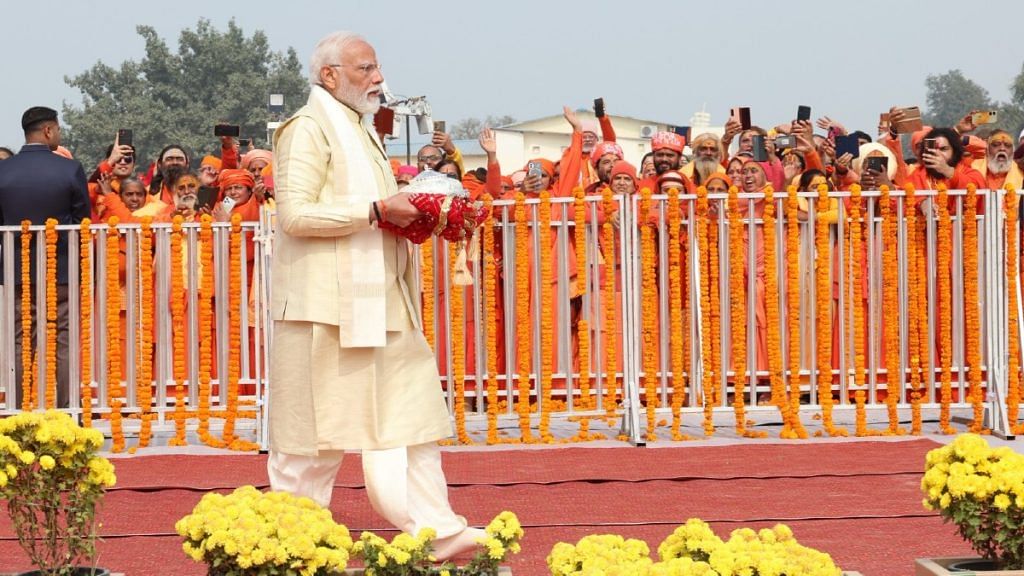As Indian Air Force choppers showered petals on the precincts of the Ram temple in Ayodhya on Monday, it was clear that the majesty of the Indian state was consecrating and installing the power of Hinduism. While commentators breathlessly announced the installation of the Ram temple as a ‘civilisational’ moment, I am struck by the squeamishness of not naming it for what it is—the arrival of the Hindu state itself.
As the only one without any constitutional position, RSS chief Mohan Bhagwat was at the centre of the supreme ritual to anoint New India that is indeed Bharat. Prime Minister Narendra Modi, in his speech, announced that 22 January marked the beginning of a new era. The Ram temple would bear witness to this new era of fulfilment and success. If in doubt, Modi also made it forcefully clear that there is no room for nirasha or disappointment. The injunction is to enjoy it all.
This moment of high and new pageantry has rearranged the shared symbols of collective and national life with a distinct emotive and psychic map. Super-sized and speedy highways across the country have been strewn with images of the temple plastered over G20 posters that had announced Bharat or New India to the world only a few months ago as city squares have been drenched in saffron flags. Bhagwat chose not the emotion and injunction of enjoyment but tapasya or sacrificial work. He ended his short speech by extolling and tying the two narratives of world-leading Bharat or the Vishwaguru with the era of the Ram Mandir. Temples embody authority as they command devotion, in enjoyment or abjection.
Also read: Congress boycott right. Ayodhya event not about Ram, but coronates Hindutva as state religion
Temple power
In his classic study entitled Worship and Conflict, anthropologist Arjun Appadurai lays bare with precision and detail the work of temples, deities, and order. Simply and crassly put, temples and the deity exude and distribute sovereign power and authority. This is not power and rule over simply a domain but an endless process that ties and expands itself through ritual. Lord Ram as the sovereign then is not merely a symbolic topping over a nation. Through the ritual of pran pratistha, literally the anointing of life, the deity is made a real and intelligent but divine being that oversees, shares, and supplies authority. The PM’s speech was unambiguous in declaring the new and current age of Ram as the presiding deity and authority of the nation.
In the case of Ayodhya, we have paid less attention to the ritual power of the deity and temple in constructing and maintaining a new sovereign order. Precisely because the rise of the Ram temple has been tied to long-dead empires, the focus has been entirely on history.
For decades, Indian public debate took on a legal and juristic view, debating whether a temple had existed where Babri Masjid was established in the sixteenth century. As such, the emotive freight has been the whipping up of humiliation. Swapan Dasgupta, the early ideologue of the temple movement, went on the airwaves in the days leading up to today’s ceremony, to explain the work of humiliation that India’s secular compact had exacerbated. It was quaint if not altogether touching to be reminded of secularism in this context. Secularism has lost the potency today even as a form of scorn, let alone a shared ideal. Dasgupta’s successors in the commentariat such as Hindol Sengupta anointed 22 January as the inauguration of the ‘Second Republic.’ Who can dispute it? But in this moment of euphoric decoloniality, I wish he had spared us this reference to the French Revolution! I do wish that Sengupta or any other commentator had named it for what it is—the coming of the Hindu Rashtra.
Also read: Two photographs bookend my understanding of India & my place in it as an Indian-Muslim
Dating the Hindu Rashtra
It was striking that across the speeches from the podium, from Uttar Pradesh Chief Minister to the RSS chief to the PM himself, the exile of Lord Ram from his birthplace was given an expanse of 500 years. Yes, back to the Mughals and the overturning of the mosque. To be sure, from its moment of genesis in 1923, in the works of Vinayak Savarkar, Hindutva took a millennial view of its political mission. For all the rise and fall of empires in that half millennium, and to say nothing of the civilisational expanse, the Ram temple of today has a short and rather speedy history. The arrival of temporal power for Hindutva, to be sure, has been swift. It is entirely linked to India’s recent history of democracy.
Conspicuous by their absence, protagonists such as LK Advani and even their political opponents such as Lalu Prasad, though faded today, are very much part of India’s living memory. In a short period of thirty years, from political and cultural obscurity, the cause of the Ram temple has transformed India in its entirety. From party politics to the nature of legal claims and disputes, from cultural warfare to symbolic and psychic investments, India or Bharat in its projection is undeniably Hindu today. The pluralism that defines India’s identity and grandeur appear as a colourful backdrop for this new era. Any protest does not qualify even as a spoiler, but evokes some wistful nostalgia to a bygone era. Or so I felt as the Preamble to the Indian Constitution appeared periodically on social media.
Perhaps, a new date and a much grander ritual and spectacle awaits the official anointment of the Hindu state. If the speed of the recent past is anything to go by, that wait will not be long.
In his speech, the Prime Minister asked, ‘what next?’ The injunction was to express no disappointment. So, as instructed, enjoy!
Shruti Kapila is Professor of History and Politics at the University of Cambridge. She tweets @shrutikapila. Views are personal.
(Edited by Prashant)
